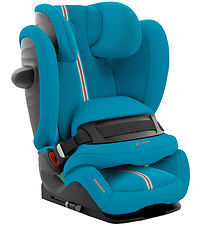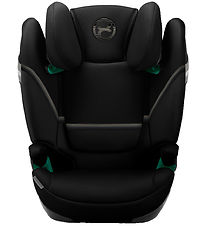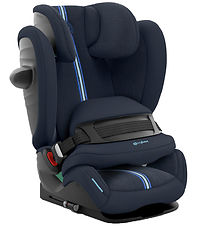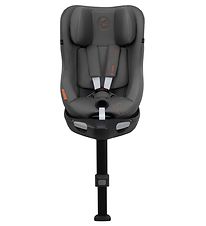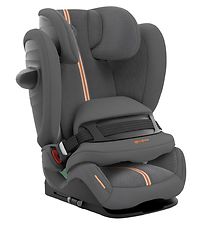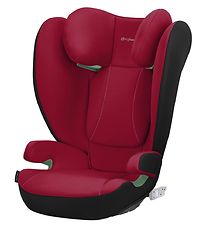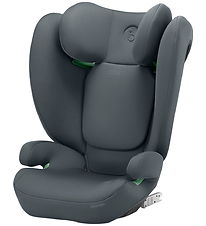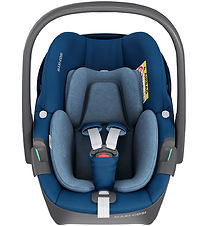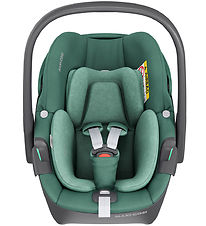Kids and Infant Car Seats
195Car seats? Find your car seat here
A good car seat is and will be alfa and omega when you have to take your child out for a drive. Here, both your child's safety and comfort in the car apply, so it is important that you find the right car seat for your child.
There are a number of things that you need to take into account when looking for a car seat for your child. In the last pair years, there have been new standards for both the execution and testing of car seats, which have helped to provide new and safer car seats than before.
It is therefore important that you find the right car seat. Here you will find a wide selection of car seats from several large and international car seats brands, so you have a large selection to choose from.
Here we will try to give you as much input as possible for your choice of car seat, so that you can find the right car seat that meets your needs without compromising safety.
Car seat 9-36 kg: How to find the right car seat
You will find a large selection of car seats if you are looking for a new car seat with a weight between 9 and 36 kg. You can either use our category for car seats based on weight, or you can find more about which weight the individual car seats are suitable for in the product descriptions for the various models.
With a 9-36 kg car seat, you have a car seat that you should be able to use for several years. That is why it is important that you look at a car seat for kids between 9-36 kg, which can be adjusted in height, so that it can accompany your child in the coming years.
A car seat for kids weighing 9-36 kg must actually be used from the time the kid goes from a baby car seat until the kid can use a booster seat, so it will be a number of years in which it will be used.
There are several rules of thumb to be based on when you should choose a car seat 9-36 kg. In addition to the weight, it is typically at the age of 2 that you have to climb into such a car seat, as the kid frames a weight of 9 kg.
If you already choose to change to a car seat that is designed for up to 36 kg, then you also have a car seat that you can use until it is time for a booster seat, rather than having to go out and change again before then.
With i-Size standard, however, it is the kid's height that you have to look at instead of the weight. Based on i-Size, you must therefore look at the kid's length rather than age and weight.
Car seat 9-36 kg with isofix
You can easily find a car seat 9-36 kg with isofix here in the shop. Most car seats today have isofix as standard. The standard i-Size only applies to isofix car seats, so you can always count on your 9-36 kg car seat with i-Size to have isofix.
You can find a large selection of car seats 9-36 kg in our range with isofix. You can always see in the product description itself for the individual 9-36 kg car seat whether it has isofox or not. In the vast majority of cases, however, the car seat will have isofix.
Car seat 15-36 kg with isofix
For the older kids, a slightly larger car seat is required before you have to switch to a booster seat. Here, a car seat 15-36 kg with isofix is the obvious choice, as it is made for older kids, without having to take into account the considerations that you get in a car seat that must be able to accommodate both very young and older kids.
With a car seat 15-36 kg with isofix, you get a car seat that can accompany the kid from little to big child. With a car seat 15-36 kg, there is both a focus on safety and the comfort that is required, so that you don't get too many protests from your child that he or she would rather sit in the car without a car seat.
You can easily install a car seat 15-36 kg in your car when it has isofix. Then you just click it in place via isofix, after which you put the seat belt on the kid.
You can gradually use a car seat 15-36 kg with isofix in all new cars, as isofix is a legal requirement in all new cars from 2014 onwards. So regardless of which car you have, as long as it is from 2014 or later, you can use a 15-36 kg car seat in it.
We have a wide range of car seats 15-36 kg with isofix from a large number of strong brands when it comes to car seats. You will find several different models and variants of the different car seats, so you can easily find just the car seat that has the focus you are looking for.
Car seat for newborns? The kid's first car seat
It is perhaps the car seat that most parents spend the most time researching before buying it? especially if you are a first-time parent. It is of course a car seat for newborns and babies that we are talking about. The kid's first car seat.
Figuring out which car seat for newborns to choose can be something of a science, as there are many factors that come into play.
Most car seats for newborns today come with a base for? or a base that can be purchased and installed in the car. The base makes it easier for you as a parent to put the baby car seat in the car? and take it out again, as it is simply clicked onto the base, rather than having to fasten it with a seat belt. However, both parts are approved in Denmark.
As always, safety is the focus when it comes to car seats for newborns. Therefore, the various manufacturers of baby car seats also place large emphasis on safety. You will find, among other things, both baby car seats with 3-point and 5-point harnesses, depending on which brands you choose. In some countries, 5-point seat belts are now a legal requirement.
In your purchase of a car seat for newborns, it is important that you make up your mind whether you should first of all have a car seat that must be clicked onto a base or not. Several of the manufacturers also make car seats that can be clicked onto, for example, a frame that can be used for a stroller, so it gives a two in one effect.
Our various car seats for newborns are available in several different models, where it will often be the choice of fabric and color that differentiates the individual models. Some of the different baby car seats also have a large focus on the kid's comfort in the car seat. Of course, all this plays a role when choosing a car seat for newborns.
Car seat for baby
A car seat for baby is essential for your child's safety in the first period when you are out car. Car seats for babies also have a different design than the car seats you find for slightly older kids.
The baby lies more down in the car seat, which gives the car seat an effect like a shield, where the rear-facing direction of the baby car seat in particular means that the back of the car seat itself becomes shock-absorbing and presses the kid down into it in the event of a collision.
If you have a very little baby, you can get an insert for your baby car seat, which makes the kid lie better in the car seat.
The shell in a car seat for babies means that it absorbs the shock, so that the energy the car seat is hit by is minimized in relation to how much is passed on to the kid in it. Therefore, it is a good idea to look at baby car seats that score high in safety tests.
When talking about a car seat for babies, it is a car seat for kids from 0 to 15 months. It can be a little difficult to make it up in kilos, but when you think of a car seat of 0-13 kg, then you are not completely wrong with this one, as the kid by then will have a size and length that, that it would be a good idea to look at a larger car seat, which at that time will provide better safety than a car seat for babies will.
Car seat 0-13 kg
If you look at it in terms of weight, a car seat 0-13 kg is what is also called a baby car seat or a car seat for newborns.
In most cases, the weight corresponds to a child of up to two years, after which a larger car seat is required for your child, who by then will have outgrown a car seat 0-13 kg.
It is also important that you look at your child's length when choosing a car seat. In connection with i-Size standard, the length has replaced the classic weight classifications when it comes to car seats.
A 0-13 kg car seat will be the kid's first car seat, which can be used until the kid is around one and a half to three years old? depending on the kid's size.
Our range of car seats for kids between 0-13 kg includes baby car seats from a wide range of brands that are known internationally for both their quality and safety. You can always use our filter to find the different types or colours you want. You can find all our car seats 0-13 kg in our category for just these car seats.
Car seat 0-18 kg
If you choose a car seat 0-18 kg instead, you get a car seat that can be used for a little longer than if you choose a car seat designed for 0-13 kg.
In most cases, many choose to look at a car seat 0-13 kg, after which they switch to a car seat 9-36 kg or 15-36 kg when the kid gets too large for the baby car seat.
Depending on when you change the car seat, you may have to have two or three car seats before you finally switch to a booster seat for your child. Here, however, it is important that you think about the kid's safety, rather than how many car seats it requires during the first pair years. Both you and your child will be happy about it in the long track.
Car seat for kids aged 1,2, 3 and 4 years
We carry car seats for kids of all ages, so regardless of whether you are looking for a car seat for kids aged 1,2, 3 or 4, you will find it here in our range.
If you are looking for a car seat for a child of 1 or 2 years, we would recommend that you look for car seats in the category car seats 0-13 kg, as it will typically be these car seats that suit your child best.
If, on the other hand, you are looking for a car seat for kids aged 3 or 4, we recommend that you look at either car seats 9-18 kg, car seats 9-36 kg or car seats 15-36 kg, as this is where you will find your future car seat.
Do you need a car seat with a swivel function?
To that extent, Car seats with a swivel function have become a popular item with parents worldwide. A car seat with a swivel function has the large advantage that it is easier for you to put the kid in the car seat and take the kid out again, as the car seat can be turned.
Some reversible car seats can be turned 360 degrees, while others are limited to being able to turn to the side, so you can take the kid out easily and conveniently.
You will most often find car seats with a swivel function for kids up to four years of age. If you look at the weight here, when you need to find a reversible car seat, it will be car seats up to 13 or 18 kg that will have this turning function.
The reason why the swivel function is not often found in a baby car seat or in car seats for older kids is that for the smallest children the car seat must be clicked into the base, while for the older kids it is assumed that they themselves can sit in the car seat.
If you have a car seat with a swivel function, it is important that you ensure that the kid sits facing backwards for as long as possible. It is not a legal requirement in Denmark? but it is in several others countries.
Car seat for front seat without isofix
You can also get it without isofix if it needs to be on the front seat. Here you must fit the car seat with the seat belt instead of with isofix.
We have several car seats for the front seat without isofix. Under the individual car seats, you can read more about whether it can be fitted with the car's three-point seat belt, or whether it can only be fitted with isofix.
See the different models of car seats for the front seat without isofix here in the category, where you will find car seats from a wide range of strong brands.
Car seat rules: This is what you need to know about the legislation for car seats
In Denmark, there are no rules for when your child may sit in the front seat? but, as long as your child is not taller than 135 cm, he must be fastened in approved safety equipment that suits the kid's age, height and weight. In others words, you must use a car seat until your child is at least 135 cm tall.
Both several manufacturers and interest organizations recommend that you let your child sit in the front seat as long as the kid is under 140 cm. This recommendation is due to safety reasons. These are general recommendations that do not affect the safety of the individual car.
The recommendation is due, among other things, to the car's airbag, which is designed to protect people over 140 cm.
That's what the law says about kids in car seats
- Kids must sit in a car seat until they are at least 135 cm tall
- The car seat must match the kid's weight and height
- The car seat must be approved with ECE 44-04 or ECE R129 (i-Size)
- It costs a cut in the driver's license + a fine if kids under 15 are not properly fastened
You should be aware that all the mentioned rules and guidelines for the use of car seats and others mentioned products on this page are discussed based on the Danish legislation. Therefore, the rules may be different in others countries. You should therefore not use this information as a starting point if you are located in a country other than Denmark. Here, you must instead start from the relevant legislation in your country of residence.
Kids in the front seat
Kids are welcome to sit in the front seat? but it is recommended that they not do so for safety reasons. This is due to several things.
In Denmark, kids shorter than 135 cm must be restrained - with safety-approved equipment. However, there are no rules as to whether the kid may sit in the front seat. In Denmark, that decision is left to the parents.
When can kids sit in the front seat?
As a rule, Kids must sit in the front seat from day one. However, according to the legislation, they must be fastened with safety-approved equipment, as long as they are under 135 cm tall.
However, several organizations recommend that you wait to let kids sit in the front seat until they are 140 cm tall.
If you let your child sit in the front seat before he or she is over 135 cm tall, there is a requirement to use the airbag, which must be switched off if there is a child in the front seat. This is because the deployment of the airbag can injure the kid, as it is designed to protect adults. Always remember to read these instructions and requirements for the individual car before letting a child sit in the front seat.
You will find a large number of the approved safety measures that you must use if you want to let kids sit in the front seat here on our site. This applies to both baby car seats, car seats for kids in different sizes and, not least, booster seats.
When can kids sit in the front seat in a car seat?
Kids may sit in the front seat from day one, but there are requirements for their safety, both when they sit in the front seat and the back seat of a car.
Until kids are 135 cm tall, they must be restrained with safety-approved equipment. This is a legal requirement in Denmark.
It is not a legal requirement, but it is recommended that you have the car seat facing backwards as long as the kid can sit that way.
How tall and how old must kids be to sit in the front seat?
In Denmark, there is no minimum height or age for when kids can sit in the front seat in Denmark. However, they must be properly secured in terms of safety - based on the legal frames, until they are at least 135 cm high.
It is only after the kid is 135 cm tall that you may use a booster seat. Until then, an approved car seat is a requirement.
When can kids sit without a car seat?
There is no fixed age limit for when you can sit without a car seat. It's the height that matters. Here the limit is 135 cm.
However, most people use a booster seat afterwards until the kid is taller. While the legislation says up to 135 cm, there are more and more interest organizations that recommend up to 140 cm.
When you choose to do it, when your child is over 135 cm tall, is of course up to you. But car seats are created to increase your child's safety in the car, so from that point of view you can argue that the longer you leave your child in a car seat, the better it will be for your child's safety.
Best car seat: How do I find the best car seat?
Do yourself the favor of ignoring sales pitches like?best in testing?,?test winner? and the like. Because that does not necessarily give you the best car seat.
First of all, it applies to the car seat's safety - also at the expense of comfort and others special features, such as whether or not the car seat can be rotated.
Look at the safety results of the car seat in the various tests. In particular, keep an eye on the safety score in tests from the German ADAC.
Then you should look at your child's comfort in the car seat, because your child is going to spend some time there, so it is important that you look at the comfort so that your child sits properly.
When you need to find the best car seat, last but not least you have to look at the little things about the car seat, which can make everyday life easier for both the kid and the parents. It may be whether it is the best car seat for you if it can rotate, or if the baby car seat can also be mounted on a pushchair stand.
The best car seat for you will be the one that does not compromise on safety, while at the same time meeting the needs for comfort and others helpful factors in everyday life.
Car seat test: You need to keep an eye on these
You probably often hear terms like?test winner? and?best in test?, when you look at car seats, but which tests should you look out for?
It is important that you have a strong source criticism here, because both manufacturers, retailers and various sites often use these terms.
One of the car seats tests that you should keep an eye on is ADAC. ADAC (Allgemeiner Deutscher Automobil-Club) is the world's largest motor association. ADAC was founded in 1903. Today, ADAC is particularly known for their testing of car seats, which are tested within safety, service, ergonomics, harmful substances and processing and cleaning of the car seats.
Several of the manufacturers here use the test from ADAC as both a guideline and a guide for further product development. That is why it is a really good idea that you as a consumer also use these tests, rather than relying on various test answers that are not always objective.
Car seat with isofix
Most new car seats today have isofix. The same applies to cars from 2014 onwards, where isofix has become standard. So if you have a car from after 2014, you can basically expect that you can fit your car seat with isofix on both the front seat and the back seat.
We have a large selection of car seats with isofix, so you will have no difficulty finding a car seat with isofix, regardless of whether you are looking for a baby car seat with isofix, a car seat for older kids with isofix? or a booster seat for that matter.
i-Size car seat: Everything you need to know about i-Size car seats
i-Size is the new standard for approvals of car seats from 2008 onwards. Until now, i-Size has functioned alongside the former ECE brand, but from now on only i-Size will be the applicable standard for approvals of car seats.
The i?et in i-Size stands for isofix. Size covers the fact that in future you look at the height of the kid, rather than looking at age or weight. You will therefore see that looking at kilos when looking for a car seat will be phased out.
While there was also a division of the size of the car seats in relation to weight, there will also be that with the height at i-Size. Here the car seats are divided into 40-105 cm, 61-105 cm and 100-135 cm. The smallest size will basically be for kids from 0 to 4 years, while the middle size will be for kids between 6 months and up to 4 years. The largest size will typically be for kids aged 4 and up.
An advantage of the i-Size car seats is that they allow rear-facing installation of the car seats for kids up to four years of age. This is because it is simply safer for kids to sit rear-facing in their car seat.
Car seat size: How to find the right car seat
You should basically look at your child's length when choosing a car seat. In the past, the guideline has been the kid's weight, but today more is seen on the kid's length? both when testing and producing new car seats. In the new approval standard for car seats, i-Size, the kid's length is also considered.
So the first thing you have to look at is your child's height when you need to find the right size car seat. When you have your child's height in place, you can see if the individual car seat fits your child. You can see which lengths the individual car seats are intended for in the product descriptions.
Once you have found the right size for your new car seat, you can look at the different features that distinguish the different car seats from each other. Here you can look at the materials, safety and of course also the kid's comfort in the car seat.
Rear-facing or forward-facing car seat
It doesn't matter if you have a forward-facing or rear-facing car seat for your child. Rear-facing car seats are more and more recommended, as the back shield protects the kid extra against collisions, as the kid is pushed down into the car seat in the event of a collision.
However, you must not use a rear-facing car seat on the front seat unless the airbag is switched off. This is required by law, as the deployment of the airbag can be fatal for the kid if he is sitting in a rear-facing car seat in the front seat.
If your child is to sit in the front seat without the airbag switched off, he must be in a forward-facing car seat.
Car seats with harness mounting
You will also find car seats with harness mounting. Most often, these car seats also have isofix, but can also be fitted with the car's seat belt. Here you use the car's seat belt to fasten the car seat in the car.
You must be aware that it is not the kid in the car seat that you fasten, but rather the car seat. The kid must still be fastened with the harness that is in the car seat.
Car seat with base
It is alfa and omega that your car seat is positioned correctly in the car, as otherwise it does not provide optimal safety for your child. Many therefore choose a car seat with a base? or a car seat that can be mounted on a base.
When you choose a car seat with a base, you get a base for your car seat, where you simply click the car seat onto the base when you need to go out for a drive. You therefore don't have to fasten the car seat with the safety belt.
Several manufacturers have made it incredibly easy to put the car seat down on the base, so you just slide it down and click into place.
A car seat with a base means that you can correctly set the car seat to stand in water, whereby it stands correctly in relation to the safety measures for which it was designed - even if the seat in the car is not completely straight or in water.
We have several different car seats with bases. You can find them both as a set, where the base is included, or you can choose to buy them separately.
Which car seat should I choose?
You must choose the car seat that you think is the right one for your child when you look at safety, comfort and price.
It can be a jungle to find the right car seat, especially if you are a first-time parent and need to find the right car seat.
There are different brands, sizes and models, so it may well require a little guidance and research to find the right one. Especially if you haven't tried it before. That's why we at Kids-world try to help you with a wide range of information - both here on the page and under the individual car seats, where you can read much more about their various features.
Always remember to make sure that you use your car seat within the prescribed frames based on the applicable legislation. In this way, you use your car seat optimally, while at the same time ensuring optimal safety for your child.
Booster seats for kids
You will also find a large selection of booster seats in our range. We have both booster seats that can be installed with and without isofix, so you have several options for using the individual booster seat.
Booster seats for kids are usually the last car seat, so to speak, as they are used when the kid has grown too large for the car seat? i.e. over 135 cm tall, but still does not sit optimally and wants to go up in height when car.
The seat belt cushions can either be mounted in the car with isofix, if the seat belt cushion has it, or you can mount the seat belt cushion with the car's seat belt.
When should you switch to a booster seat?
You can and must change to a booster seat when your child is at least 135 cm tall. Until then, your child must sit in an approved car seat when you car. So you can and must switch to a booster seat when your child is over 135 cm tall.
How to get a car seat offer
Most will have between two and four car seats for the individual child during the years that the kid uses a car seat. It can therefore be a good idea to keep informed about good car seat offers. You can get them directly in your inbox if you sign up for our newsletter. Then you will receive an offer for car seats directly by email when we run either a sale or get new car seats home.
The information, legal requirements and usage habits mentioned in this text are based on Danish legislation and Danish customs. The information may therefore not be accurate in other countries than Denmark. You should take this into account when purchasing a car seat or car seat accessories to ensure compliance with the applicable legislation in your country of residence.


